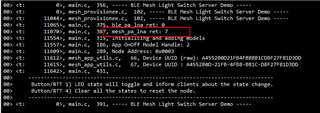HI ,
1.
'''
ble_stack_init();
err_code = sd_ble_opt_set(BLE_COMMON_OPT_PA_LNA, &ble_pa_lna_opts);
APP_ERROR_CHECK(err_code);
#if MESH_FEATURE_GATT_ENABLED
gap_params_init();
conn_params_init();
#endif
mesh_init();
mesh_pa_lna_gpiote_enable(&m_pa_lna_params);
```
2.
```
static void provisioning_sd_ble_opt_cb()
{
uint32_t err_code;
err_code = sd_ble_opt_set(BLE_COMMON_OPT_PA_LNA, &ble_pa_lna_opts);
APP_ERROR_CHECK(err_code);
}
static void start(void)
{
rtt_input_enable(app_rtt_input_handler, RTT_INPUT_POLL_PERIOD_MS);
if (!m_device_provisioned)
{
static const uint8_t static_auth_data[NRF_MESH_KEY_SIZE] = STATIC_AUTH_DATA;
mesh_provisionee_start_params_t prov_start_params =
{
.p_static_data = static_auth_data,
.prov_sd_ble_opt_set_cb = provisioning_sd_ble_opt_cb,
.prov_complete_cb = provisioning_complete_cb,
.prov_device_identification_start_cb = device_identification_start_cb,
.prov_device_identification_stop_cb = NULL,
.prov_abort_cb = provisioning_aborted_cb,
.p_device_uri = EX_URI_LS_SERVER
};
ERROR_CHECK(mesh_provisionee_prov_start(&prov_start_params));
}
else
{
unicast_address_print();
}
mesh_app_uuid_print(nrf_mesh_configure_device_uuid_get());
ERROR_CHECK(mesh_stack_start());
__LOG(LOG_SRC_APP, LOG_LEVEL_INFO, m_usage_string);
hal_led_mask_set(LEDS_MASK, LED_MASK_STATE_OFF);
hal_led_blink_ms(LEDS_MASK, LED_BLINK_INTERVAL_MS, LED_BLINK_CNT_START);
}
````
I set PA / LNA in the following way. I found that when the device is connected, it will be disconnected and will no longer be connected. How to set PA / LNA correctly?During the development process, I found that Nordic mesh was particularly unstable. We were developing products and were very worried.



